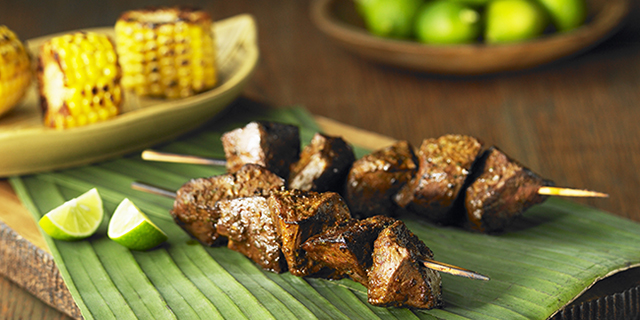Delicate iron ceiling supports said to be designed by Gustave Eiffel take my mind off of the grim tableau that’s taking place in a blender three feet away from me. Amazonian herbs and fruits, juice from powdered roots, and an adorable, apricot-sized frog are about to become an elegant lady’s afternoon smoothie. I’m nowhere near Paris. In fact, I’m in the heart of Mercado San Camilo, a vast public market in Arequipa, Peru. And for reasons I can’t understand, I’ve spent the last 15 minutes, transfixed, at a market stall whose hand-painted sign reads Jugo de Rana. Frog juice.
A cupful of this frothy concoction is said to boost brainpower, reduce stress, and rouse the ol’ libido. But during this stop on a two-week journey to my parents’ homeland, my normally adventurous palate is screaming for a time-out. I heed the call.
Peruvian cuisine has been on the lips and palates of foodistas around the world for the past few years, turning dishes like lomo saltado and cebiche into household words. Certain Peruvian chefs have achieved near cult status both locally and abroad. But there are a few Peruvian dishes that may never grace the pages of a glossy food magazine, simply because they may appeal to only the most intrepid of food lovers.
Case in point: the cuy, or guinea pig. A native of the Andes and domesticated more than 7,000 years ago, guinea pigs were eaten during religious ceremonies by pre-Columbian cultures in Peru and neighboring countries. Sixteenth-century Spanish conquistadors introduced the guinea pig to the Old World, where the irresistible little critters endeared themselves to Europeans and soon became household pets. Today in Peru, cuy is on the menu at the humblest of roadside eateries as well as the trendiest of novoandina restaurants.
Two days before the frog juice encounter, I found myself at one of Arequipa’s many picanterías, a casual restaurant where spicy foods and family-style dining are the norm. After decades of avoiding what some may consider a rite of passage for any American with Peruvian roots, I cave in to the pressure from my tablemates and accept my destiny. The waiter arrives with a sizzling platter and in seconds I’m face-to-deep-fried-face with my first cuy chactado.
Next up, taking a bite out of cuy and a recipe for a traditional Peruvian bite.
[ pagebreak ]As I prepare to take the first bite, I console myself with the fact that guinea pig meat is actually good for you. Low in cholesterol, high in protein, and very lean, it’s probably healthier than a burger. And if you can get past the fact that it’s served intact (head and arms included), the crispy battered crust gives way to succulent white meat that’s flavorful without any trace of gaminess.
While some of the newer upscale restaurants in Lima feature nouvelle renditions of cuy, there’s nothing like the capital city’s street food scene. Humitas, tacu tacu, and anticuchos trace their origins to the Africans who were brought to Peru as slaves in the sixteenth century. Anticuchos, or skewered marinated beef kabobs, have existed in Peru since the 1500s, but African cooks prepared them with beef heart. The African version stuck, and today anticuchos are popular at barbecues or straight off an anticuchera’s cart.
I always get a pang when I leave Peru, as work and daily life prevent me from making regular trips back to visit cousins, aunts, and uncles. But a family recipe for anticuchos never fails to evoke the warmth of my Peruvian relatives, even when we’re thousands of miles apart. As for the frog juice, I’d rather manage my stress with yoga and the occasional pisco sour.
- 2 whole beef hearts
- 6 cloves fresh garlic, crushed
- 1 teaspoon ground dried red chili
- 1 tablespon whole cumin seeds
- 1 rounded tablespoon salt
- 1 teaspoon paprika
- 1 tablespoon ground pepper
- 1 1/2 cups red wine vinegar


![Making Mealtime Matter with La Familia: Easy Sofrito [Video]](https://thelatinkitchen.com/wp-content/uploads/2015/10/sofrito-shutterstock__0-500x383.jpg)
![Easy Latin Smoothies: Goji Berry Smoothie [Video]](https://thelatinkitchen.com/wp-content/uploads/2015/12/goji_berry-shutterstock_-500x383.jpg)
















![Fun and Fast Recipes: Fiesta Cabbage Salad [Video]](https://thelatinkitchen.com/wp-content/uploads/2015/11/fiesta_cabbage_slaw-shutterstock_-500x383.jpg)









